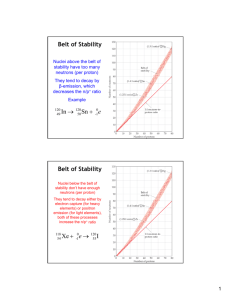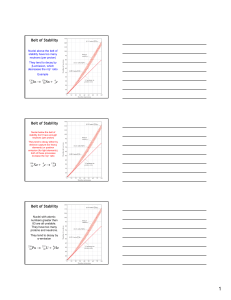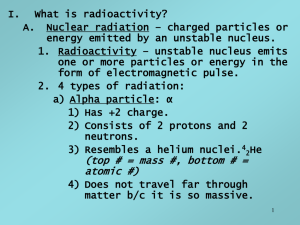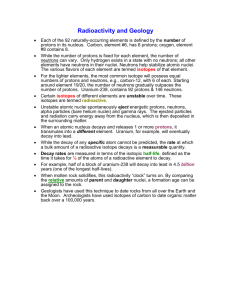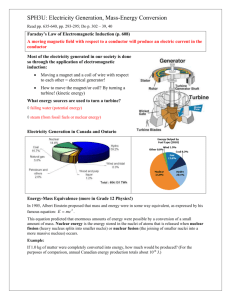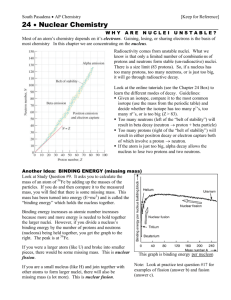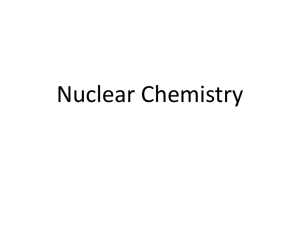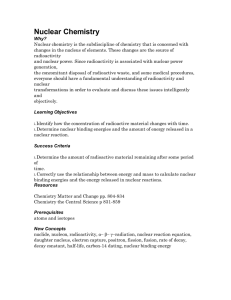Chapter 21 Nuclear Chemistry
advertisement
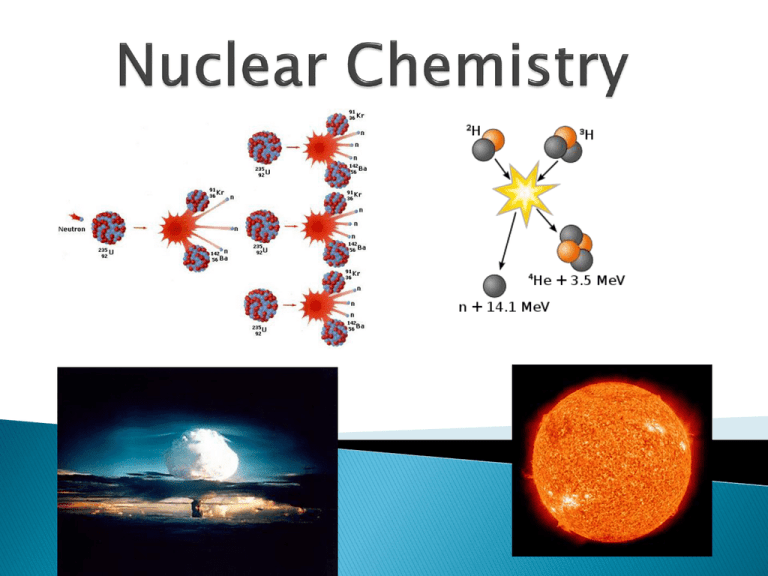
Remember that the nucleus is comprised of the two nucleons, protons and neutrons. The number of protons is the atomic number. The number of protons and neutrons together is effectively the mass of the atom. Not all atoms of the same element have the same mass due to different numbers of neutrons in those atoms. There are three naturally occurring isotopes of uranium: ◦ Uranium-234 ◦ Uranium-235 ◦ Uranium-238 It is not uncommon for some nuclides of an element to be unstable, or radioactive. We refer to these as radionuclides. There are several ways radionuclides can decay into a different nuclide. Henri Becquerel Discovered radioactivity 1. 2. 3. 4. Neutron/proton ratio Nuclear binding energy per nucleon Isotopes with even numbers of nucleons tend to be more stable (magic numbers) Radioisotopes with longer half-lives are more stable than those with shorter ones. Loss of an -particle (a helium nucleus) 4 2 He Uranium-238 goes through alpha decay. 238 92 U 234 90 Th + 4 2 He Loss of a -particle (a high energy electron) 0 −1 0 or −1 e Iodine-131 goes through beta decay. 131 53 I 131 54 Xe + 0 −1 e Loss of a positron (a particle that has the same mass as but opposite charge than an electron) 0 1 11 6 C e 11 5 B + 0 1 e Loss of a -ray (high-energy radiation that almost always accompanies the loss of a nuclear particle) 0 0 Addition of an electron to a proton in the nucleus ◦ As a result, a proton is transformed into a neutron. 1 1 p + 0 −1 e 1 0 n Only type of transmutation that has the particle on the reactant side. Write nuclear equations for the following. 1. Alpha decay of polonium 212. 2. Carbon -14 goes through beta decay. 3. Potassium-39 decays by positron emission. 4. Silver-106 captures an orbital electron. The time required for one half of any given mass of a radioactive nuclide to decay. Carbon-14 = 5730 years (beta) Francium-220 = 27.5 seconds (alpha) Uranium-235 = 710 million years (alpha) mr = mo/2n mr = mass remaining mo = the original mass n = the number of half lives n = t/t1/2 n = number of half lives t = total time t1/2 = the half-life A sample of a radioactive substance with an original mass of 16.0 g, was studied for 8.00 hours. When the study was completed, only 4.0 g of the substance remained. What is the half-life of the substance? A sample of iodine-131 had an original mass of 16.0 grams. How much will remain after 24 days if its half-life is 8.0 days? Any element with more than one proton (i.e., anything but hydrogen) will have repulsions between the protons in the nucleus. A strong nuclear force helps keep the nucleus from flying apart. Neutrons play a key role stabilizing the nucleus. Therefore, the ratio of neutrons to protons is an important factor. For smaller nuclei (Z 20) stable nuclei have a neutron-toproton ratio close to 1:1. As nuclei get larger, it takes a greater number of neutrons to stabilize the nucleus. The shaded region in the figure shows what nuclides would be stable, the so-called belt of stability. Nuclei above this belt have too many neutrons. They tend to decay by emitting beta particles. Nuclei below the belt have too many protons. They tend to become more stable by positron emission or electron capture. There are no stable nuclei with an atomic number greater than 83. These nuclei tend to decay by alpha emission. Large radioactive nuclei cannot stabilize by undergoing only one nuclear transformation. They undergo a series of decays until they form a stable nuclide (often a nuclide of lead). Nuclear transformations can be induced by accelerating a particle and colliding it with the nuclide. These particle accelerators are enormous, having circular tracks with radii that are miles long. One can use a device like this Geiger counter to measure the amount of activity present in a radioactive sample. The ionizing radiation creates ions, which conduct a current that is detected by the instrument. 1. 2. 3. 4. 5. 6. Smoke detectors (Am-241) Food irradiation (gamma rays) Archeological dating (carbon-14) Geological dating (Uranium-238) Detection of disease (I-131, Na-24, Tc99) Treatment of cancer (Ra-226 and Co-60) There is a tremendous amount of energy stored in nuclei. Einstein’s famous equation, E = mc2, relates directly to the calculation of this energy. In chemical reactions the amount of mass converted to energy is minimal. However, these energies are many thousands of times greater in nuclear reactions. For example, the mass change for the decay of 1 mol of uranium-238 is −0.0046 g. The change in energy, E, is then E = (m) c2 E = (−4.6 10−6 kg)(3.00 108 m/s)2 E = −4.1 1011 J Bombardment of the radioactive nuclide with a neutron starts the process. Neutrons released in the transmutation strike other nuclei, causing their decay and the production of more neutrons. This process continues in what we call a nuclear chain reaction. If there are not enough radioactive nuclides in the path of the ejected neutrons, the chain reaction will die out. Therefore, there must be a certain minimum amount of fissionable material present for the chain reaction to be sustained: Critical Mass. Nuclear Reactor In nuclear reactors the heat generated by the reaction is used to produce steam that turns a turbine connected to a generator. The reaction is kept in check by the use of control rods. These block the paths of some neutrons, keeping the system from reaching a dangerous supercritical mass. Three Mile Island Nuclear Plant in PA Accident in 1979 Chernobyl 1986 Fusion would be a superior method of generating power. ◦ The good news is that the products of the reaction are not radioactive. ◦ The bad news is that in order to achieve fusion, the material must be in the plasma state at several million kelvins. ◦ Tokamak apparati like the one shown at the right show promise for carrying out these reactions. ◦ They use magnetic fields to heat the material.
